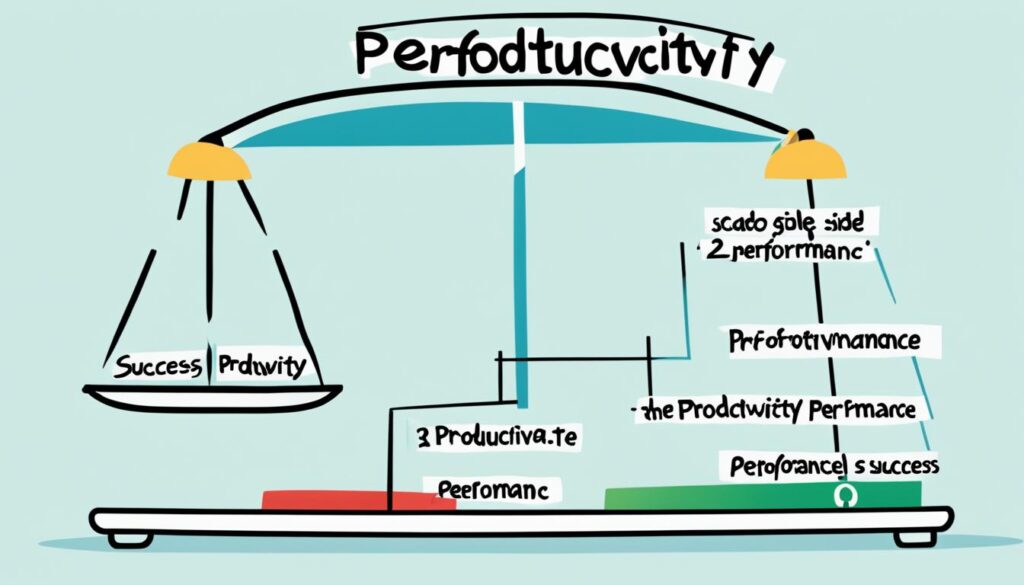Boost Your Success: Productivity vs Performance

Are you constantly striving to achieve more in your professional life? Do you find yourself juggling multiple tasks and feeling overwhelmed by the ever-growing to-do list? The key to unlocking your true potential lies in understanding the difference between productivity and performance.
While the terms “productivity” and “efficiency” are often used interchangeably, they actually represent distinct aspects of your work. Productivity measures the rate of production, focusing on the quantity of output you can generate within a given time frame. On the other hand, efficiency measures how effectively you utilize your resources to complete a task, emphasizing the optimal utilization of time and effort.
So, the question is: Are you focusing on productivity or performance in your professional endeavors? Is it enough to simply produce more, or should you be striving to do things better and more efficiently?
Key Takeaways:
- Productivity focuses on the quantity of output, while efficiency emphasizes optimal resource utilization.
- Increasing productivity means accomplishing more tasks in the same timeframe, while enhancing efficiency involves accomplishing tasks with fewer resources.
- To achieve optimal results, it is essential to strike a balance between productivity and performance.
- By understanding the nuances between productivity and performance, you can adopt strategies to boost your success in the workplace.
- Measuring both productivity and performance allows for identifying areas of improvement and implementing effective strategies for growth.
Understanding Productivity and Performance
Productivity and performance are two terms that are often used interchangeably, but they actually refer to different aspects of work. Productivity is the measure of how efficiently any organization can utilize its available resources to generate goods or services. It quantifies the output generated per unit of input. On the other hand, efficiency refers to the ability to accomplish tasks or goals with minimal waste, effort, or resources. It focuses on achieving the desired outcome in the most economical and effective manner.
It is important to recognize the differences between productivity and performance in order to optimize output. Productivity is about crossing tasks off your to-do list and feeling that sense of accomplishment, while efficiency is about doing things right from the start and finding the best and often quickest way to achieve a goal without unnecessary detours. Both productivity and efficiency are essential for achieving success in any endeavor.

Now, let’s delve deeper into the specifics of measuring productivity and efficiency. By understanding how to effectively measure these key metrics, you can identify opportunities for improvement and implement strategies to enhance your overall performance.
The Measure of Productivity
Productivity is typically measured by evaluating the output generated per unit of input. This can be quantified in various ways, such as:
- The number of products or services produced in a given time frame
- The revenue generated per employee
- The amount of work completed per hour
Organizations often use productivity metrics to assess the effectiveness of their operations and identify areas for improvement. By measuring productivity, you can gauge the efficiency of your resources and workflows, enabling you to make data-driven decisions and optimize your performance.
The Measure of Efficiency
Efficiency, on the other hand, focuses on accomplishing tasks or goals with minimal waste, effort, or resources. It is about finding the most effective and economical way to achieve desired outcomes. Efficiency can be measured by:
- The time taken to complete a task or a project
- The amount of resources consumed in relation to the output produced
- The level of accuracy and quality achieved
By evaluating and measuring efficiency, you can identify bottlenecks, eliminate unnecessary steps, and streamline your processes. This not only improves overall productivity but also optimizes resource allocation and enhances the effectiveness of your operations.
Understanding and measuring both productivity and efficiency are crucial for maximizing your performance and achieving your goals. By striking the right balance between the two, you can enhance your output, optimize your resources, and drive success in your endeavors.
| Productivity | Efficiency |
|---|---|
| Measures the output per unit of input | Focusses on accomplishing tasks with minimal waste and effort |
| Quantifies the number of goods or services produced | Evaluates the time, resources, and accuracy required to achieve desired outcomes |
| Optimizes resource utilization and workflows | Streamlines processes and eliminates unnecessary steps |
Measuring Productivity and Performance
As a business owner, it’s crucial to measure productivity and performance to ensure that your company is operating efficiently and effectively. By understanding how to measure these key metrics, you can identify areas for improvement and implement strategies to drive success.
When it comes to measuring productivity, one common method is to track the quantity of output produced within a specific timeframe. This can be done by counting the number of products created or services provided. For example, if you run an e-commerce business, you can measure productivity by examining the number of products sold per day or week.
Efficiency, on the other hand, can be measured by evaluating the ratio of useful output to total input. This provides insight into how well resources are utilized to achieve desired outcomes. By understanding the efficiency of your processes, you can identify opportunities to streamline workflows and reduce waste.
There are various tools and methods available to measure productivity and efficiency. Time-tracking software can help you monitor the time spent on different tasks and identify areas of improvement. Task management systems allow you to track the progress and completion of specific projects. Surveys and performance reviews provide valuable feedback from employees and stakeholders, offering insights into their work habits and areas for growth.
By measuring productivity and performance, you can gain a comprehensive understanding of your business’s strengths and weaknesses. This information enables you to develop strategies to increase productivity, optimize performance, and achieve higher levels of success.
Example of a productivity measurement table:
| Productivity Metrics | Measurements |
|---|---|
| Number of products created | 100 per day |
| Services provided | 50 per week |

Strategies for Improving Productivity and Performance
To enhance workplace productivity and boost overall performance, implementing the right strategies is essential. By optimizing processes, streamlining tasks, and utilizing effective techniques, organizations can improve productivity, enhance performance levels, and increase efficiency. Here are some proven strategies to help you achieve optimal results:
1. Consolidate Software Processes
Consolidating software processes can significantly improve efficiency by reducing switching costs and creating centralized data sources. By integrating various software solutions, teams can streamline workflows, eliminate duplication of efforts, and enhance collaboration. This boosts productivity by minimizing time spent on switching between different tools and ensures that all data is easily accessible in one place.
2. Document Processes and Create Scalable Procedures
Documenting processes and creating scalable procedures is crucial for achieving consistent productivity and enabling new employees to achieve a high level of production from the start. Well-documented procedures provide a clear roadmap for tasks, reducing the learning curve and enabling individuals to work efficiently. Scalable procedures ensure that businesses can handle increased workload and accommodate growth without sacrificing quality.
3. Optimize Meetings and Use Time Boxing Techniques
Excess meetings can hinder productivity, wasting precious time that could be better spent on high-impact work. Evaluating the necessity of each meeting and reducing their frequency can free up significant time for focused tasks. Additionally, implementing time boxing techniques, which involve allocating specific time slots for each task, helps prioritize work and ensures that sufficient time is dedicated to essential assignments.
4. Delegate and Outsource Tasks
Delegating and outsourcing tasks can effectively distribute workload, allowing employees to focus on more critical responsibilities. By entrusting appropriate tasks to capable individuals or external resources, organizations can optimize productivity and achieve better performance outcomes. Delegation and outsourcing also enhance collaboration by leveraging diverse expertise and reducing individual workload.
5. Leverage Automation Tools
Automation tools can revolutionize processes, significantly increasing efficiency, and reducing manual errors. By automating repetitive and time-consuming tasks, organizations can save valuable time, eliminate human errors, and optimize resource utilization. From email automation to data entry and project management, leveraging automation tools enables teams to work smarter, not harder.
By implementing these strategies, organizations can create a productive and efficient work environment, leading to enhanced performance and optimal outcomes. Constantly seeking opportunities to improve productivity and performance is essential for long-term success and staying competitive in today’s fast-paced business landscape.

| Strategy | Description |
|---|---|
| Consolidate Software Processes | Reduce switching costs and centralize data sources to improve overall efficiency. |
| Document Processes and Create Scalable Procedures | Ensure new employees can quickly achieve a high level of production and provide a structure for growth. |
| Optimize Meetings and Use Time Boxing Techniques | Reduce time wasted on unnecessary discussions and prioritize tasks effectively. |
| Delegate and Outsource Tasks | Distribute workload and free up time for more high-impact work. |
| Leverage Automation Tools | Streamline processes, reduce manual errors, and increase efficiency. |
Importance of Productivity and Efficiency in Business
You know that productivity and efficiency are crucial for the success of your business. But what exactly do these terms mean and why are they so significant? Let’s explore the importance of productivity and efficiency in driving operational excellence and organizational performance.
Productivity: Maximizing Output with Fewer Resources
Productivity is all about maximizing output while minimizing the use of resources. It’s the key to achieving business productivity and ensuring sustainable growth. When your team operates at peak productivity, they can produce more goods or services in a given time frame, which leads to increased profits and competitive advantage.
For example, let’s say you own a manufacturing company. By optimizing your production processes and workflow, you can significantly increase the number of products you manufacture in a day without requiring additional resources. This not only boosts your bottom line but also allows you to meet customer demands more efficiently.
Efficiency: Delivering High-Quality Output and Customer Satisfaction
Efficiency, on the other hand, focuses on doing things right from the start and delivering high-quality output. It ensures that your business operations are streamlined and effective, reducing waste and unnecessary effort. By improving efficiency, you can achieve better results with the same amount of resources.
Let’s consider a customer service department. By implementing efficient processes and empowering your team with the right tools and training, you can provide prompt and accurate support to customers, ensuring their satisfaction and loyalty. This not only leads to repeat business but also enhances your company’s reputation.
Optimizing Productivity and Efficiency: The Key to Success
By focusing on both productivity and efficiency, you can achieve optimal results and drive business success. Increasing your productivity allows you to produce more output, while enhancing your efficiency ensures that the output is of the highest quality. This winning combination leads to improved customer service, reduced costs, and increased operational effectiveness.
Measuring productivity and efficiency is essential for identifying areas of improvement and creating strategies for growth. By implementing performance metrics and automation tools, you can gain valuable insights into your business operations, make data-driven decisions, and establish a culture of accountability.
Let’s illustrate the importance of productivity and efficiency in business with a table:
| Key Benefits | Productivity | Efficiency |
|---|---|---|
| Increase in output | ✓ | ✓ |
| Optimization of resources | ✓ | ✓ |
| Improved customer satisfaction | ✓ | ✓ |
| Lower costs | ✓ | ✓ |
Note: The table highlights the key benefits of both productivity and efficiency in driving business success.
By optimizing your business environment, utilizing automation tools, and continuously improving your performance, you can enhance your productivity and efficiency levels. This will enable your organization to thrive in today’s competitive landscape and achieve long-term success.

Conclusion
Productivity and performance are the driving forces behind achieving success in your business. Understanding the distinction between productivity and efficiency is crucial for optimizing your operations. Productivity measures the amount of work you can accomplish in a given timeframe, while efficiency focuses on how effectively you utilize your resources to complete tasks. By implementing effective strategies and techniques, you can improve efficiency levels, maximize productivity, and achieve your desired outcomes.
Continuously striving for higher levels of productivity and efficiency is essential for business growth and success. It is important to optimize your performance and boost effectiveness in order to stay competitive in today’s fast-paced market. By incorporating productivity techniques into your workflow and optimizing performance outcomes, you can maximize efficiency, achieve your goals, and pave the way for continued success.
Remember, productivity and efficiency go hand in hand. By optimizing your processes, utilizing time-saving tools, and implementing performance optimization strategies, you can create a productive and efficient work environment. Embracing these practices will empower your team and drive your business towards greater success. So, maximize your productivity, optimize your efficiency, and unlock the full potential of your business.
FAQ
What is the difference between productivity and efficiency?
Productivity measures the rate of production, while efficiency measures how many resources are needed to complete a task.
How can productivity and performance be measured?
Productivity can be measured in terms of quantity, such as the number of products created or services provided. Efficiency can be measured by dividing the useful output by the total input.
How can I improve productivity and performance in the workplace?
Strategies for improvement include consolidating software processes, documenting procedures, reducing unnecessary meetings, delegating tasks, and leveraging automation tools.
What is the importance of productivity and efficiency in business?
Productivity allows organizations to produce more with fewer resources, leading to increased profits, while efficiency ensures high-quality output, leading to customer satisfaction and loyalty.
How do productivity and performance contribute to business success?
By optimizing productivity and efficiency levels, businesses can achieve their desired outcomes, reduce costs, and improve customer service, leading to overall success and growth.






